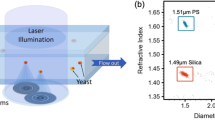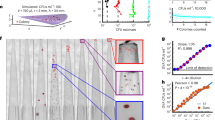Abstract
Yeast viability can be accurately quantified using BacLight, a kit which so far has been used only for bacterial analysis. Upon staining, viable cells can be differentiated from non-viable ones by either confocal laser scanning microscopy (CLSM), epifluorescence microscopy, or flow cytometry. Using Saccharomyces cerevisiae as a model, viabilities quantified by CLSM deviated an average of 1.7% from the actual data, and those determined by flow-cytometry by 1.4%.
Similar content being viewed by others
References
Biswas K, Rieger K, Morschhäuser J (2003) Functional analysis of CaRAP1, encoding the Repressor/activator protein 1 of Candida albicans. Gene 307: 151–158.
Boyd AR, Gunasekera TS, Attfield PV, Simic K, Vincent SF, Veal DA (2003) A flow-cytometric method for determination of yeast viability and cell number in a brewery. FEMS Yeast Res. 3: 11–16.
Cahill G, Walsh PK, Donnelly D (1999) Improved control of brewery yeast pitching using image analysis. J. Am. Soc. Brew. Chem. 57: 72–78.
Dan NP, Visvanathan C, Basu B (2003) Comparative evaluation of yeast and bacterial treatment of high salinity wastewater based on biokinetic coefficients. Bioresour. Technol. 87: 51–56.
Haugland RP (1996) Handbook of Fluorescent Probes and Research Chemicals, 9th edn. Eugene, OR: Moleculer Probes Inc.
Hope CK, Wilson M (2003) Measuring the thickness of an outer layer of viable bacteria in an oral biofilm by viability mapping. J. Microbiol. Meth. 54: 403–410.
Lehtinen J, Virta M, Lilius E (2003) Fluoro-luminometric realtime measurement of bacterial viability and killing. J. Microbiol. Meth. 55: 173–186.
Millsap KW, van der Mei HC, Bos R, Busscher HJ (1998) Adhesive interactions between medically important yeasts and bacteria. FEMS Microbiol. Rev. 21: 321–336.
Narvhus JA, Gadaga TH (2003) The role of interaction between yeasts and lactic acid bacteria in African fermented milks: a review. Int. J. Food Microbiol. 86: 51–60.
Oh KB, Matsuoka H (2002) Rapid viability assessment of yeast cells using vital staining with 2-NBDG, a fluorescent derivative of glucose. Int. J. Food Microbiol. 76: 47–53.
Sami M, Ikeda M, Yabuuchi S (1994) Evaluation of the alkaline Methylene Blue staining method for yeast activity determination. J. Ferment. Bioeng. 78: 212–216.
Author information
Authors and Affiliations
Rights and permissions
About this article
Cite this article
Zhang, T., Fang, H.H. Quantification of Saccharomyces cerevisiae viability using BacLight. Biotechnology Letters 26, 989–992 (2004). https://doi.org/10.1023/B:BILE.0000030045.16713.19
Issue Date:
DOI: https://doi.org/10.1023/B:BILE.0000030045.16713.19




